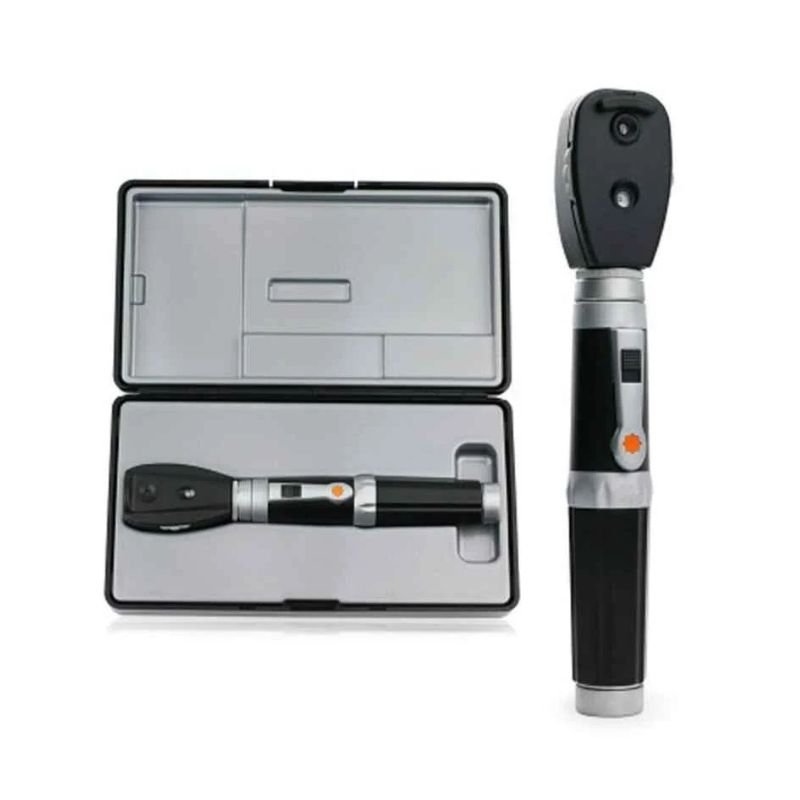Introduction of Direct ophthalmoscope
Direct ophthalmoscope, an instrument for inspecting the eye. The ophthalmoscope generally is considered to have been envisioned in 1851 by the German physiologist Hermann von Helmholtz, but it is occasionally credited to English mathematician and originator Charles Babbage, who in 1847 cultivated an instrument made sure to seem to be the ophthalmoscope. The ophthalmoscope transformed into a model for later sorts of endoscopy. The device involves solid areas for a that can be composed into the eye by a little mirror or precious stone. The light sparkles off the retina and back through a little opening in the ophthalmoscope, through which the reviewer sees a nonstereoscopic enhanced image of the plans at the back of the eye, including the optic circle, retina, retinal veins, macula, and choroid. The ophthalmoscope is particularly useful as an assessing gadget for various visual sicknesses, similar to diabetic retinopathy.
Types of Direct ophthalmoscope:
It is of two significant sorts:
Direct ophthalmoscope is one that delivers an upstanding, or unreversed, picture of roughly multiple times amplification.
Aberrant ophthalmoscopy is one that creates an altered, or turned around, picture of 2 to multiple times amplification.
Each kind of ophthalmoscopy has a unique sort of ophthalmoscope:
The immediate ophthalmoscope is an instrument about the size of a little spotlight (light) with a few focal points that can amplify up to around 15 times.[1] This sort of ophthalmoscope is generally regularly utilized during a routine actual assessment. The dish ophthalmoscope has a bigger essential focal point with a variable centering, taking into consideration a more extensive field of view.
A circuitous ophthalmoscope, then again, is a light joined to a headband, notwithstanding a little handheld focal point. It gives a more extensive perspective to the eye. Moreover, it permits a superior perspective on the fundus of the eye, regardless of whether the focal point is blurred by cataracts.[1] A backhanded ophthalmoscope can be either monocular or binocular. It is utilized for fringe surveys of the retina.
To know more click here.
How does it work?
It is of two significant sorts:
Direct ophthalmoscope one that delivers an upstanding, or unreverThere are various kinds of ophthalmoscope, and it generally pays (with the lights still on) to really get to know the different dials and switches. At the point when turned on, the transmitted light ought to be:
Splendid — go it to most extreme
White — overlook any remaining tones
Round — once more, disregard every one of the cuts and crosses; turn the dial until you get a round circle.
Many individuals find it befuddling to need to contemplate their own glasses and the patient’s glasses. Try not to stress over this — set every one of the numbers on the ophthalmoscope to “0.” Request that the patient eliminate their glasses — you can keep your own on or eliminate them as you like. Contact focal points needn’t bother with to be taken out.sed, picture of roughly multiple times amplification.
Aberrant ophthalmoscopy one that creates an altered, or turned around, picture of 2 to multiple times amplification.
How to use an ophthalmoscope
The Direct ophthalmoscope appears to be a basic instrument. Be that as it may, truly, “fundi NAD” written in the notes frequently signifies “not really observed.” The ophthalmoscope is easy to utilize however it requires some training. Attempt to start involving it in each neurological assessment — you’ll before long get its hang.
Where the patient should look
It is vital to get your patient to focus on an exact region (for instance, the edge of the room or drape rail). In the event that you are too obscure about this they will move their eyes. Educate the patient to see this spot regardless of anything else — regardless of whether you disrupt everything. This spot ought to be found so they are looking somewhat away from you when they are inspected — that is, to the left when you analyze the right eye as well as the other way around
Each kind of ophthalmoscopy has a unique sort of ophthalmoscope:
The immediate ophthalmoscope is an instrument about the size of a little spotlight (light) with a few focal points that can amplify up to around 15 times.[1] This sort of ophthalmoscope is generally regularly utilized during a routine actual assessment. The dish ophthalmoscope has a bigger essential focal point with a variable centering, taking into consideration a more extensive field of view.
A circuitous Direct ophthalmoscope then again, is a light joined to a headband, notwithstanding a little handheld focal point. It gives a more extensive perspective to the eye. Moreover, it permits a superior perspective on the fundus of the eye, regardless of whether the focal point is blurred by cataracts.[1] A backhanded ophthalmoscope can be either monocular or binocular. It is utilized for fringe survey of the retina.
For more information about these products click here.







